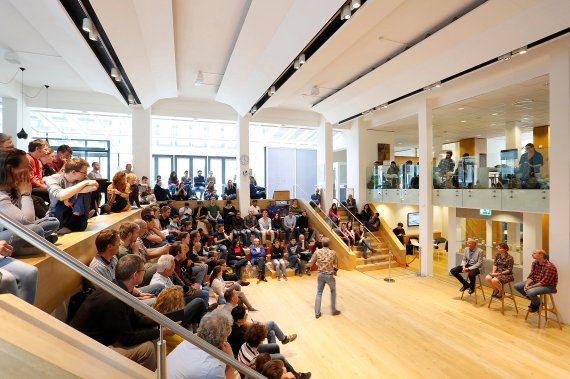CRISPR-Cas technology could unleash a plant breeding revolution, say experts. With this molecular technology you can make precise changes to DNA to arm plants against disease, drought or salinization, to name but a few possible applications. The technique is fast, accurate and cheap: reason enough in 2015 for the top journal Science to proclaim CRISPR-Cas the scientific breakthrough of the year.
But while companies in the US are adopting the technique at lighting speed, the European Court slammed on the brakes last summer. It decided to bring CRISPR-Cas under the rules for genetically modified organisms (GMOs), which means CRISPR crops have to go through a long and expensive admissions procedure (see inset).
The EU’s current policy lacks credibility and is untenable in the long term
John van der Oost, CRISPR discoverer
LACKING CREDIBILITY
This is an untenable situation, says CRISPR discoverer John van der Oost. The personal professor of Microbiology was one of the speakers at the CRISPR debate on 20 May. He explains to a full house in Impulse that the current GMO policy lacks credibility and is untenable in the long term. To start with its credibility: CRISPR-Cas changes DNA much more precisely than mutagenesis, which is used in vegetable and fruit breeding to date. In these techniques, breeders force changes in the DNA in a hit-and-miss fashion using chemicals and radiation. In the case of tomatoes, about 10 to 20 million base pairs have been changed using this blunt tool. The tiny scissors of the CRISPR-Cas technique, by contrast, cut and paste 20 to 30 base pairs, after which we can also check whether the intervention has been successful. And yet CRISPR-Cas is subjected to strict safety controls, while mutagenesis is not. That is the wrong way round, says Van der Oost. Moreover, he says the European policy will be impossible to implement because crops created with CRISPR-Cas cannot be differentiated from crops created with conventional breeding methods – cross-breeding and selection. Old GMO techniques always left a signature in the form of a recognizable genetic construction, but CRISPR-Cas does not do that. So institutes that provide analyses, such as Wageningen Food Safety Research, cannot determine whether a consignment of food in Rotterdam harbour was made using CRISPR-Cas or conventional breeding techniques. This has become a pressing problem now that countries such as the US, Canada, Australia, Brazil and Russia have relaxed their approval procedures and will be exporting CRISPR-Cas foods to Europe.

CRISPR-Cas has not yet delivered any products that solve societal problems, said Michelle Habets of the Rathenau Institute in Impulse during the debate. Photo: Aldo Allessie
NEW PROCEDURE
So Europe will have to change the way it deals with CRISPR-Cas somehow. But how? Supporters of the technology argue for a liberal approval policy with little or no policing. But this fails to take into account the widespread opposition to biotechnology in Europe or the fact that no risk analyses have been done yet on CRISPR crops. A certain degree of filtering and control does seem to be needed. The question is therefore: what approval procedure should take the place of the redundant GMO policy?
Esther Kok, a GMO expert at Wageningen Food Safety Research, proposed a revision of the approval procedures several years ago. She participated in European projects in which independent research was done on the need for and usefulness of rat studies aimed at identifying unintended effects of GMOs. The research confirmed that these studies do not generally have any added value. Kok proposed that we could save a lot of time, money and rats by scrapping compulsory animal experiments as a standard procedure. Instead of focussing on the technique –
The question is whether CRISPR will deliver on its promises
GMO or not – we should focus on the characteristics of the product being bred: what is new and what is already known about the product? Has the risk been assessed before? Using these data, her institute would be able to decide whether a short or an extensive risk analysis is needed, proposed Kok.
NOT DELIVERING
But a nuanced risk analysis tailored to the characteristics of the CRISPR product is not enough to silence all the criticism from opponents. One of their arguments for restricting approval of the new technique is that it is not delivering on the claims made for it – namely, that it will produce more food and make agriculture more sustainable. At present, CRISPR-Cas has produced no more than a mushroom that doesn’t go brown so fast, a sweeter strawberry and soya beans with less saturated fat, said Michelle Habets of the Rathenau Institute at the Resource debate. None of these CRISPR products have solved societal problems or made the food supply chain more sustainable, she concluded. Moreover, there is a power issue at stake in the plant-breeding world. The companies that want to use CRISPR-Cas concentrate aim primarily at making a profit. They have little or no interest in the position of farmers, the freedom of choice of consumers, or social justice, said Habets in the debate. So it is by no means certain that CRISPR-Cas will in practice deliver on its promise.
OWNERSHIP ISSUE
It could be argued that the large seed companies are currently investing a lot in sustainability, including new varieties that are more resistant to diseases, pests, drought and salinization. Sustainability is business, but the question of ownership still arises. Current patenting policy protects and benefits not just the discoverers but also the big companies that have the money and lawyers to develop and protect the technology.
Here too, the current European approval policy is not having the intended result, the debate revealed. Van der Oost pointed out that the extensive risk analyses required make CRISPR-Cas so expensive that only the big breeding companies can use the technique. Monsanto’s opponents thus play right into Monsanto’s hand. Habets commented that the patenting law and the monopolization of the seed sector make the multinationals stronger.

John van der Oost: ‘The extensive risk analyses make CRISPR so expensive that only big companies can make use of the technique.’ Photo: Aldo Allessie
TESTING FOR IMPACT
So how can we ensure that CRISPR-Cas is used ‘for good’? By establishing a European framework of criteria for GMOs, the Rathenau Institute advised earlier this year. The institute asked experts, civil society organizations and businesses which criteria should be included in such a framework. What came out of this was that the modified crop should promote sustainability and diversity in agriculture. It should increase the grower’s freedom of choice and improve the quality of the landscape. And it should strengthen the export position of Dutch agriculture, the position of farmers, and knowledge and innovation.
Norway is already well on the way to establishing this kind of testing, based on social impact. In 1993, the country passed the Gene Technology Act, to ensure that only GMOs get approved that have been tested on ethical issues, social impact and sustainability. The Norwegians have now worked out two proposals for a new GMO policy. During the Resource debate, Rathenau Institute scientist Habets described the broad lines of these proposals. For genetic changes that can also occur naturally and be made with classic breeding techniques, registration is compulsory. There is a fast-track procedure for genetic changes involving genes within one species (cisgenesis). So only genetic changes across species and synthetic DNA are submitted to an extensive GMO test, which also looks at ethics, impact and sustainability.
In the second Norwegian proposal, the authorities look first at whether the CRISPR products meet the social criteria, and only then at the technique being used. So, for example, if the Norwegian government wants to reduce pesticide use in agriculture, the CRISPR-Cas crops that are resistance to diseases and pests will pass the tests easily, and crops that are resistant to pesticides will not.
BREAKING THE DEADLOCK
The Norwegian approach weighs up both the risks and the social benefits of gene technology, and therefore seems like a good way of breaking the present deadlock in Europe. CRISPR pioneer John van der Oost made clear at the debate in Impulse that he is in favour of it. After all, new crops that help us reach climate targets would get on to the market faster than they do at present. The question remains as to whether the European Union is ready for that. And as to who should sit on the committee that gets to decide what ‘good’ means.
Meanwhile in Brussels:
| The European Court of Justice decided last year that new breeding techniques, including CRISPR-Cas, are subject to legislation for genetically modified organisms (GMOs). Crops developed using CRISPR-Cas must therefore go through an extensive and costly risk analysis as part of the approval procedure. The court’s argument is that, unlike the traditional process of cross-breeding and selection, CRISPR-Cas has no history of safe use. The Court’s ruling is binding as long as the European Commission does not change the legislation. The new European Commission will probably decide later this year whether it will prepare new GMO legislation. It is not clear at all whether such legislation will exempt CRISPR-Cas from the strict rules applying to GMOs. The European member states are divided on the topic of gene technology and the decision-making process has been in deadlock for years. Meanwhile, civil servants in Brussels are thinking about adaptations to the law. The European Commission’s Joint Research Centre has published a report stating that the current GMO procedure should be changed, given that CRISPR products are no longer distinguishable from classically bred plants. And the EU’s Agricultural and Fisheries Council has put changing the GMO policy on its agenda. |
Open dialogue during CRISPRcon:
| The conference CRISPRcon, to be held on the Wageningen campus on 20 and 21 June, will bring people together to discuss the future of CRISPR-Cas and related new gene technology. These technologies can make a huge contribution to the quality of life, but there are also serious concerns about safely, the integrity of life, and unfair distribution of ownership. The aim of CRISPRcon is to promote an open dialogue on these aspects of the subject. The conference will be in English. More information: crisprcon.org |

 Almost everyone at the Resource debate in Impulse expressed support for more flexible approval procedures for CRISPR-Cas. Photo: Aldo Allessie
Almost everyone at the Resource debate in Impulse expressed support for more flexible approval procedures for CRISPR-Cas. Photo: Aldo Allessie 

